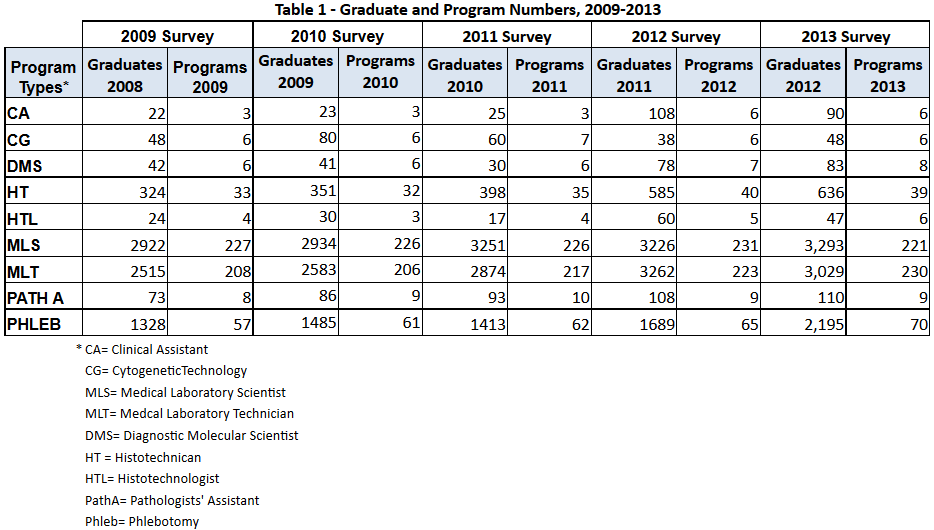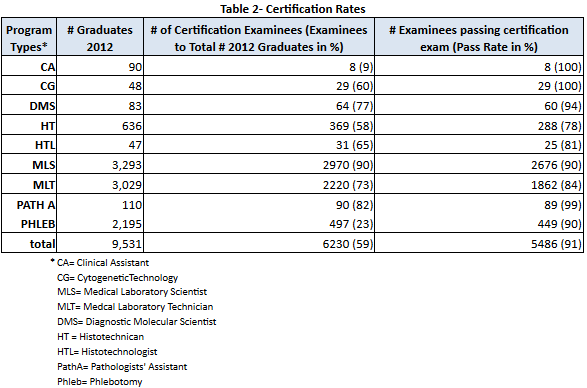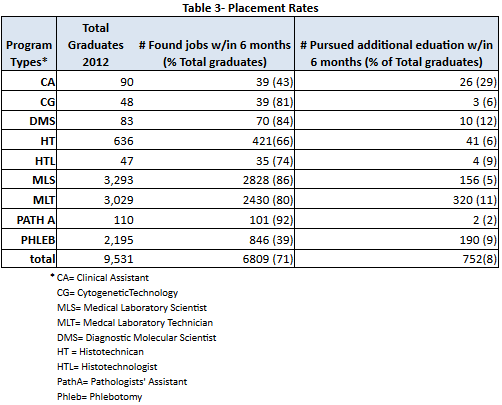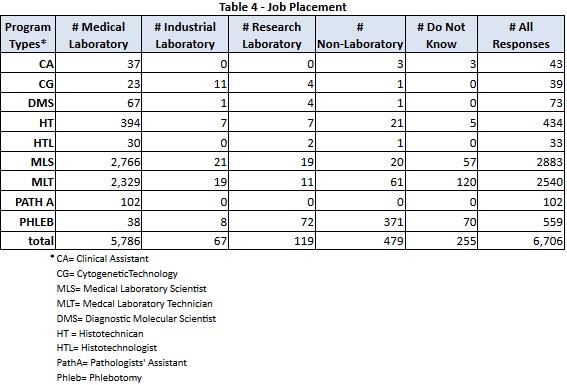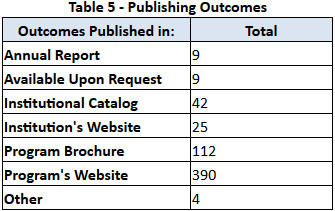CEO’S CORNER: Findings from the Annual Survey
Survey dissemination and data:
The Annual Survey of Programs (Joint Survey), a collaborative effort of NAACLS and the Board of Certification (BOC), was disseminated to the program directors of 595 NAACLS accredited and approved programs in 2013. Submission of the completed survey is required annually by NAACLS accreditation and approval standards. Presented here are data indicating numbers of NAACLS accredited and approved programs and graduates, certification examination pass rates, placement rates, and reported student outcomes.
Five (5)-year longitudinal data for the numbers of programs and graduates by program type appear in Table 1. The data reveal increases in the total number of programs from 567 in 2009 to 595 in 2013 and that trend is seen for all program types except Cytogenetics (CG) and Medical Laboratory Science (MLS). The number of CG programs was 6 in both 2009 and 2013 while the number of MS program declined from 227 in 2009 to 221 in 2013. The program types showing greatest growth include Medical Laboratory Technician (MLT) (208 in 2009; 230 in 2013) and Phlebotomy programs (Phleb) (57 in 2009; 70 in 2013). The number of Clinical Assistant (CA), Diagostic Molecular Science (DMS), Histotechnician (HT), Histotechnologist (HTL), and Pathologist Assistant (PathA) increased during the 5-year period but the statistical significance of that growth, if any, is difficult to determine based on the smaller numbers of programs.
Over the 5-year period increases are seen in the numbers of graduates from NAACLS accredited and approved programs. With the exception of CG program graduates, all program types reveal an increased number of graduates and, in some cases, the increases are striking. Numbers of graduates of CA, DMS, HT, HTL and Phleb programs indicate ≥40% increases while MLS, MLT, and PathA programs indicate increases of 11%, 17%, and 34%, respectively, when comparing graduate numbers for 2009 with 2013. The data suggest that, even accounting for the increased numbers of some program types, many programs have increased enrollments. This may be in response to many socioeconomic conditions including a sluggish recovery of the job market that in turn may encourage more people to pursue higher education degrees, administrative pressure on program officials to increase enrollments, more effective student recruitment strategies, increased varieties of education delivery models, and the development of innovative approaches to provision of the clinical experience.
Table 2 indicates for each program type the total number of 2012 graduates, the number and percentage of those graduates who took the relevant BOC certification exam, and the pass rates as reported by the program directors. Graduates from NAACLS accredited and approved programs are not required to take certification exams for successful completion of programs. Some graduates elect to delay or forego taking examinations and thus the number of examinees is less than the number of graduates. Also, examinees are not required to release examination scores to their respective programs so for these examinees there are no available data. As seen in Table 2, 6230 of 9531 total graduates (59%) took a BOC certification exam with the highest percentages of BOC examinees reported from MLS (90%) and Pathologist Assistant (82%) programs and the lowest from Clinical Assistant (9 %) and Phlebotomy (23%) programs. The lower percentages of Clinical Assistant and Phlebotomy program graduates taking the BOC certification exams may be the result of several certification exams offered by multiple organizations and few negative employment consequences for those lacking professional credentials. The reported pass rates for BOC examinees of all program types were 80% or higher with the exception of Histotechnician programs reporting a 78% pass rate overall.
Program directors were asked to provide the numbers of graduates who found employment positions and/or pursued additional education within six months of graduation (Table 3). It should be noted that program directors may not receive this information from graduates and for those graduates no data are captured. Also, some graduates may be both employed and pursuing further education within six months and the survey is not designed to differentiate between graduates who are employed, pursuing additional education, or both. Within those limitations, the data appear to indicate that graduates of NAACLS accredited and approved programs are successful at securing employment, with the highest employment rates reported for Pathologist Assistants (92%), Medical Laboratory Scientists (86%), Diagnostic Molecular Scientists (84%) and Cytogeneticists (81%). For each program type, a least a few graduates are reported to have pursued additional education within six months. However, the numbers of graduates pursuing additional education are not large enough to provide statistically significant patterns.
Table 4 indicates the type of institution at which graduates of NAACLS accredited and approved programs found employment. Again, graduates may or may not choose to share that information with program directors therefore the table does not reflect the total number of graduates of any program type for the survey year. Of 6706 reported graduates, 5786 secured employed in some type of medical laboratory. Only Pathologist Assistant graduates found employment exclusively in medical laboratories. Perhaps not surprisingly, Phlebotomy graduates found or continued in previous employment primarily in non-laboratory settings (371 of 559 reported graduates) compared to only 38 of 559 working in medical laboratories.
Several years ago NAACLS, to enhance accountability, adopted a change to the standards requiring all programs publish at least one student/program outcome that is accessible to the public. The most recent Joint Survey asked programs what medium is used to publish the outcome(s). Table 5 indicates that the most frequent media used to publish this information are programs’ websites or brochures, followed by the sponsoring institutions’ catalogues or websites.
It should be noted that having outcome data “available upon request” does NOT meet the standard to publish student outcome(s) in a way that is accessible to the public.
Summary of the findings:
Findings from the Joint Survey indicate an overall growth in the number of accredited and approved programs, with the exceptions of MLS and GG programs, and the greatest increases in MLT and Phlebotomy programs. The numbers of graduates for all program types except CG increased over the 5-year of survey data from 2009-2013. For several program types the increase in numbers of graduates over the time period exceeded 40% suggesting that in addition to an increase in program numbers there has also been significant growth in program enrollments. Only 6230 of 9531 total graduates (59%) from 2012 elected to take (or report taking) the relevant BOC certification exam. However there was a significant distribution across program types in the percentages of graduates doing so with MLS and PathA programs posting the highest percentages of examinees and CA and Phlebotomy programs posting the lowest. The reported pass rates for examinees was 80% or greater except for Histotechnician programs posting an overall 78% pass rate. Placement data continue to indicate that graduates of NAACLS accredited and approved programs are successful at securing employment within 6 months of graduation, with the highest employment rates reported for PathA, MLS, DMS, and CGs. No large trend of graduates seeking additional education was discerned. With the exception of Phlebotomy program graduates, most other program type graduates found relevant employment in medical laboratories. Lastly, NAACLS accredited and approved programs published one or more student outcomes in a medium that is accessible by the public in a variety of ways. The most frequently used medium types were program websites and/or brochures.
